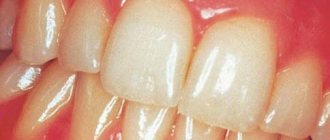If there is insufficient fluoride in the body, the following develops: list
For the smooth operation of all human life systems, a certain set of microelements is necessary.
A deficiency or excess of any of them leads to disruptions in metabolic processes, and later to the appearance of diseases. If there is insufficient fluoride in the body, a number of diseases develop. Children suffer the most from this. We will consider further what consequences this leads to. In the periodic table of chemical elements, this substance has serial number 9 and is designated by the capital Latin letter f - F
If there is insufficient fluoride in the body, it develops
Microelement deficiency can occur for several reasons:
- as a result of metabolic disorders;
- passion for protein-free diets;
- passion for carbonated sweet drinks, where there is an abundance of food coloring;
- long-term use of medications with a high content of magnesium;
- use during artificial feeding with low-quality milk formulas.
But the main cause of microelement deficiency is the insufficient use of fluoride-enriched foods in the diet.
Caries
It has long been noted that when there is insufficient fluoride in the body, caries develops, and when there is an excess, fluorosis develops. To understand how fluoride deficiency affects the development of caries, it is necessary to understand the anti-caries effect of the chemical element.
The mechanism is as follows: interacting with the mineral components of dental tissue, insoluble compounds are formed that act as protection for teeth. In addition, the ingredient precipitates calcium phosphate, which is found in human saliva. And this favors the mineralization of teeth and stops the caries process.
If there is not enough fluorine, then all these processes are disrupted. This causes late teething in babies and the appearance of caries in baby teeth.
Posture deformation
Since the microelement affects the formation of bone tissue, its insufficient amount leads to pathologies in the osteoarticular system. The appearance of pain in the joints, their deformation, and incorrect posture are the main signs of a lack of not only calcium, which is a building material for bones, but also fluoride.
Physically in nature this substance is a beautiful mineral
Brittleness of bones and teeth
Defects in the mineralization of bone and dental tissues lead to their thinning. Bones become brittle and more susceptible to fractures. After injuries, there is a slow recovery and fusion of bones at the fracture sites.
Osteoporosis
If fluoride deficiency in a child’s body manifests itself in delayed ossification, then in adults it contributes to the development of osteoporosis. This is a disease in which hollow pores form in bone tissue.
Elderly people are at risk, especially women who have decreased bone mass with age. The reasons for this phenomenon are different.
But the main one is a lack of calcium, which is better absorbed in the presence of fluoride.
You may be interested in: What is stretching?
The role of fluoride in the human body
The bulk of fluoride is concentrated in teeth and bones. Therefore, it is bone tissue that suffers most from fluoride deficiency in the body, which contributes to an imbalance in bone formation in childhood and adolescence.
What biological role does the element play?
- takes part in the formation of tooth enamel, heals microcracks in it, suppresses the formation of bacteria in the oral cavity, strengthens gums;
- is a participant in biochemical reactions;
- promotes the absorption of iron necessary for the circulatory system;
- promotes the formation of leukocytes, erythrocytes, platelets;
- necessary to maintain immunity;
- helps remove heavy metal salts and radionuclides from the body;
- promotes rapid recovery after fractures;
- strengthens nails and hair.
Daily fluoride intake
With a lack of fluoride in the body, a number of diseases develop, so it is very important to receive it in full. But you should know that the benefits of fluoride can only be if the norm of its consumption is observed. When the permissible limit is exceeded, the useful element turns into poison, which is very dangerous for humans.
The daily intake depends on age, gender, physical activity and health status. The table shows the maximum permissible limit, which is not recommended to be exceeded.
| Daily fluoride intake, mg/day | |||||||
| newborns | children | teenagers | adults | ||||
| 0 – 6 months | 7-12 months | 1-3 years | 4-8 years | 9-13 years | women | men | |
| 0,01 | 0,5 | 0,7 | 1,0 | 2,0 | 3,0 | 3,0 | 4,0 |
Where is fluoride found?
Fluoride is best absorbed by the human body from water. For this purpose, drinking water is specially fluoridated in water supplies. This is especially important for areas where the fluoride concentration in the water is less than 5 mg/l. Some countries use a different method of enrichment with an important health element. For example, in Switzerland table salt is fluoridated.
The human body receives most of the fluoride (up to 80%) from drinking water, and the rest from food.
Products
The largest amount of the chemical element is contained in the following products:
- green, black tea;
- sea fish (cod, mackerel, salmon, sea catfish, sardines);
- beef liver;
- veal, lamb;
- nuts.
Products containing fluorine and the meaning of the substance in them
Fluoride is also present in other foods, but in minimal doses:
- oatmeal;
- milk;
- chicken eggs;
- walnuts.
But it is difficult to compensate for the daily need for fluoride only by adjusting the diet, since foods contain a tiny amount of it. For example, an adult will need to drink 20 liters of milk per day to achieve the required norm.
Types of fish and the importance of the mineral they contain
Drugs and tablets
To compensate for the lack of fluoride in the body, special fluoride-containing medications are produced. They are used strictly as prescribed by a doctor. The most famous are fluoride varnish and sodium fluoride.
Fluoride varnish gel is used to prevent caries in children over 6 years of age and adolescents living in regions where the fluoride content in drinking water is low. The gel is used as a prophylactic agent to strengthen tooth enamel and gums. They are recommended to treat the teeth and gums of children who wear orthodontic plates or braces.
The pharmaceutical market today offers a wide range of tablets and capsules containing this beneficial mineral.
Sodium fluoride is recommended for the treatment of children with high levels of dental caries and in the treatment of osteoporosis. Pediatricians and dentists recommend including foods rich in calcium and magnesium in your child's diet when using fluoride-containing medications. Calcium is better absorbed if fluoride is present.
In areas where there are many factories and heavy industry, parents should be especially careful when using such medications and not use them without a doctor's prescription.
Fluoride in toothpaste
To prevent the destruction of tooth enamel due to fluoride deficiency in the body, dentists recommend using fluoride-containing toothpastes when brushing your teeth. The decision on this issue should be made not by the patient, but by his attending physician. And the answer to which toothpaste is better—without fluoride or with it—depends on many factors: the patient’s age, the condition of the periodontium, enamel, etc.
You may be interested in: Treatment of bronchitis
When purchasing fluoride-containing toothpaste, pay attention to the percentage of the chemical element. On the tube this indicator is indicated as ppm (10000 ppm = 1%). For adults, a safe level is 1500 ppm (0.15% fluoride). It is especially important to pay attention to this labeling when purchasing baby toothpaste. The concentration of fluoride depends on the age of the child:
- up to 200 ppm – for children from 2 to 4 years old;
- up to 500 ppm – for children under 8 years old;
- up to 1400 ppm – over 8 years.
Dentists do not recommend using fluoride toothpaste for children under 2 years of age. Parents should remember that fluoride has one feature - its deficiency is not as dangerous to health as its excess.
And one more thing – don’t be greedy and share on social networks! This is the best gratitude for us...
Source: https://33devici.ru/pri-nedostatochnosti-ftora-v-organizme-razvivaetsya.html
What foods contain fluoride?
Sources of fluoride should be included in the diet daily. Their long-term absence will lead to deficiency and will negatively affect the functioning of internal organs and systems. However, you should not eat too much, since excess fluoride content in foods will also lead to undesirable consequences and worsening of the condition. It is recommended to combine different products to get enough other beneficial substances.
Only useful sources should be selected. Fluoridated water and wine from vineyards treated with the pesticide cryolite also often contain a lot of the substance, but they are harmful to the body and are not recommended for consumption.
Vegetable origin
The microelement content in food can be seen in special tables. Most of the substance is found in fish and seafood. But foods rich in fluoride can be plant-based. It is especially important to include them in the menu for vegetarians and vegans.
| Product | Microelement content, mcg/100 g |
| Walnut | 685 |
| Soybeans | 120 |
| Oats | 117 |
| Barley | 106 |
| Almond | 91 |
| Pumpkin | 86 |
| Wheat, rice | 80 |
| Rye | 67 |
| Porcini mushrooms, pearl barley | 60 |
| Chanterelles | 55 |
| Beans | 44 |
Foods containing fluoride should be consumed regularly. It is also useful to drink black, green and white teas. These drinks are rich in microelements and contain antioxidants.
It is important to choose good quality natural teas that do not contain artificial colors, fragrances, or flavoring additives.
It is also acceptable to drink mineral water: per 100 ml there can be up to 0.8 mg of the substance.
Herbal teas and decoctions of medicinal plants should also be added to the diet. The microelement content is especially high in mint and rose hip decoctions. Chamomile also contains fluoride, although its concentration is much lower.
Animal origin
Fluoride concentration in food of animal origin.
| Product | Microelement content, mcg/100 g |
| Mackerel | 1400 |
| Pollock, cod | 700 |
| Vobla, chum salmon, flounder, pink salmon, horse mackerel, salmon, sprat | 430 |
| Herring | 380 |
| Egg powder | 200 |
| Acne | 160 |
| Skim milk powder | 150 |
| Sea bass | 140 |
| Chicken meat | 130 |
| Mutton | 120 |
| Full fat milk powder | 110 |
| Shrimp, tuna | 100 |
| Pork | 69 |
| Beef | 63 |
| Egg | 55 |
| Condensed milk | 35 |
| Cottage cheese | 32 |
The effect of fluoride on the human body. Lack and excess of fluoride in the body
Despite the fact that fluorine, as a halogen, is a poisonous gas, its entry into the human body is mandatory. The state of the immune, circulatory system, bone tissue, etc. directly depends on this element.
A lack of fluoride in the body provokes hair loss and the development of diseases of the oral cavity and bones. But an excess amount of the substance is much more dangerous.
Therefore, every person should know how to correctly find the golden mean.
What is this element
Fluorine (F) is a biogenic element, a very active non-metal, a strong oxidizing agent. In D.I. Mendeleev’s Periodic Table of Chemical Elements it is in group VII, in the subgroup of halogens. Reacts with metals to form salts. By its nature, F is a pale yellow gas. One of the most common elements in nature.
Normally, the human body contains 2.6 grams of the substance. The daily dose for an adult is from one and a half to five milligrams. At a temperature of 188 degrees below zero Celsius, the gas condenses.
After dropping to -228 degrees, it freezes, turning into a crystal. In nature, it is most common in the form of minerals.
Among them, the largest proportion falls on fluorite or fluorspar (CaF2).
Impact on human health
Fluoride – what does the body need? It prevents dental caries, stimulates the immune system and regulates blood circulation. If there is a deficiency of this element, the doctor may prescribe nutritional supplements containing it. But the dose must be strictly standardized. Excessive amounts can weaken the immune system and adversely affect the development of the child.
Benefits of fluoride for the human body:
- removes radionuclides and salts of heavy metals;
- increases resistance to radiation;
- participates in the formation of enamel and skeleton;
- responsible for normal hair and nail growth;
- participates in various biochemical reactions;
- stimulates the functioning of the circulatory system;
- strengthens the immune system;
- provides prevention of osteoporosis;
- prevents the appearance of caries and periodontal disease;
- slow down the work of acid-forming bacteria.
Excess F
Even without the use of supplements, the dose of the element that people take in water, toothpaste (all manufactured toothpastes contain fluoride) or food may be too high. And an excess amount of such a substance provokes serious health problems.
Once more than two grams of the substance enters the body, a person can die. When consuming more than twenty milligrams, poisoning occurs. The effect of fluoride on the human body cannot be underestimated. The main symptoms of overdose are the following:
- lacrimation;
- weakness;
- severe numbness;
- abdominal pain;
- vomit;
- diarrhea;
- itchy skin;
- fluorosis;
- bleeding gums;
- calcification;
- convulsions;
- osteoporosis;
- disturbance of sinus rhythm of the heart;
- metabolic disease;
- pneumonia;
- bone deformation;
- hypotension;
- kidney damage;
- pulmonary edema;
- damage to the central nervous system.
What is the danger?
The role of fluorine in the human body is very great. Research by scientists has shown that compounds of this element are neurotoxins - substances that have a detrimental effect on nerve cells and destroy nervous tissue. Well-known neurotoxins are alcohol and animal poisons. For example, snake venom contains components that can completely paralyze the victim in a matter of seconds.
Consumption of fluoride in an amount that exceeds the norm does not paralyze a person (at least not that quickly). But fluorides reduce memory, the ability to think, and provoke problems with spatial orientation, understanding, calculation, learning, speech, reasoning and other cognitive functions.
After prolonged exposure to fluoride on the human body, even more unpleasant consequences may occur, such as cancer, genetic DNA disorders, decreased IQ, lethargy, Alzheimer's disease, etc.
Fluorine ions inhibit some enzymatic reactions and bind important elements such as phosphorus, calcium, magnesium. This leads to metabolic imbalance.
People who work in the chemical industry are at risk of F poisoning. This can happen during the production of phosphate fertilizers or during the synthesis of compounds containing F.
In case of poisoning, burns of the mucous membranes of the respiratory tract, eyes, and skin occur. In severe cases, damage to the lungs and central nervous system is possible.
With prolonged chronic exposure, diseases such as conjunctivitis, bronchitis, pneumonia, pneumosclerosis, and fluorosis develop.
F shortage
If there is insufficient fluoride in the body, caries develops. In addition, hair falls out, nails break, bones become less strong, and the risk of fractures increases. It is also possible to develop osteoporosis and periodontal disease.
Normal absorption of iron does not occur. This phenomenon can lead to the development of iron deficiency anemia (anemia). Symptoms of this pathology:
- malaise;
- weakness;
- fast fatiguability;
- change in the taste of food;
- dry mouth;
- tongue tingling;
- dyspnea;
- cardiopalmus;
- feeling of a lump in the throat;
- the appearance of “jams”;
- dry skin;
- discomfort in the vulva area;
- drowsiness;
- headache;
- dizziness;
- fainting;
- changes in the structure of hair and nails;
- pale greenish skin.
The development of anemia is especially dangerous during pregnancy. Then there is a danger to the life of both mother and child.
What products contain
The main source of fluoride is drinking water. It is also found in black and green tea, walnuts, seafood, milk, eggs, onions, lentils, oatmeal, buckwheat, rice, potatoes, green leafy vegetables and beef liver.
Fluoride is included in food products in very small quantities, so without drinking water, you cannot get the daily requirement of the element. The exception is sea fish. Foods rich in fluoride are presented in the table below.
| Food | fluoride |
| Cod (150 grams) | 0.105 mg |
| Sea bass (150 grams) | 0.210 mg |
| Haddock (150 grams) | 0.240 mg |
| Herring, mackerel (150 grams) | 0.525 mg |
| Eel (150 grams) | 0.240 mg |
| Salmon (150 grams) | 0.870 mg |
| Smoked herring (45 grams) | 0.160 mg |
| Frozen salmon (45 grams) | 0.200 mg |
| Dried cod (45 grams) | 0.225 mg |
| Herring fillet in tomato (45 grams) | 0.960 mg |
| Chicken fillet (150 grams) | 0.210 mg |
| Chicken liver (100 grams) | 0.190 mg |
| Buckwheat, refined grain bread (60 grams) | 0.100 mg |
Fluorosis
If there is insufficient fluoride in the body, caries develops, and if there is an excess of it, fluorosis develops. F is found in all human organs and tissues, but the highest concentration is in teeth and bone tissue. Fluorides, which are part of food, are absorbed worse than those soluble in water. Therefore, the main reason for the development of fluorosis is an excess of the element in drinking water.
Much depends on the individuality of each person. Based on research results, it has been established that in areas with excessively high levels of the substance in the water, there are simultaneously people suffering from fluorosis and those whose oral cavity is absolutely healthy.
From all of the above, we can conclude that the effect of fluoride on the human body plays a very important role.
Preparations containing fluoride
There are preparations in which the substance is included in mineral complexes. And there are those in which F is an independent element. Among the second are vitafluor, sodium fluoride, fluoride varnish.
All of them are used to treat caries in people of different ages. Fluoridated water, salt and other preventative products are also produced.
They are prescribed to both treat and prevent F deficiency.
To minimize the negative impact of fluoride on the human body, it is necessary to regularly carry out preventive measures among the population in areas with high levels of fluoride in piped water.
Source: https://FB.ru/article/380332/vliyanie-ftora-na-organizm-cheloveka-nedostatok-i-izbyitok-ftora-v-organizme
Why does fluoride deficiency occur?
The main reason for fluoride deficiency is the characteristics of the area in which a person lives, that is, a lack of fluoride in water and soil. However, now few people consume only local products; many types of food “come” to us from other regions of the country and even from abroad. Therefore, fluoride deficiency is rare.
Interestingly, fluoride deficiency can be caused not only by poor nutrition, but also by the use of ultra-modern water purification systems. They work so well that they strip most of the minerals from the water, and some of them are very beneficial to health and are important for maintaining health.
Fluorine in the human body, its excess and influence
Fluorine is a gaseous natural substance that is most often found bound with other elements. For example, fluorine together with calcium forms calcium fluoride (CaF), with sodium - sodium fluoride (NaF), etc. Fluorine compounds with organic and inorganic substances are called fluorides.
Under certain conditions, fluorides can break down and form fluoride ions. Fluoride compounds are present in the earth's crust, in water, in food products, in plants, and also in the human body. Fluorine is a vital element for the human body.
Fluorine in the body takes part in the formation of the skeleton, metabolism, in case of fractures it promotes the fusion of bones, stimulates the circulatory and immune system, together with phosphorus and calcium it forms the basis of the enamel and bone tissue of the teeth.
Also, fluorine in the body helps remove heavy metal salts and radionuclides, and has a beneficial effect on the absorption of iron. The average adult body contains 2.5 to 3 grams of fluoride. The human body replenishes fluoride reserves from food and water.
According to some experts, about 60% of fluoride in the human body comes from water. Undoubtedly, fluorine plays an important role in the human body, but, unfortunately, there is a very small border between its daily norm and excess.
So the body of a healthy person needs 1-3 milligrams of this microelement for normal functioning. But even a small daily excess can turn fluoride into a powerful poison for us, which will be much more toxic than, for example, lead.
Sources of fluoride in the body
Fluoride enters our body along with food and water. Fish, meat, tea, and cereals contain fluoride compounds. When eating food rich in fluoride, our body will consume a sufficient amount of this microelement.
But if you regularly use toothpastes that contain sodium fluoride, consume water enriched with fluoride, or cook food based on such water in aluminum containers, then over time you may experience serious health problems. Fluorine in the human body inhibits iodine metabolism, but improves the absorption of iron.
The trace element magnesium, in turn, inhibits the absorption of fluoride, the level of which fluctuates depending on the concentration of calcium in the body.
Excess fluoride in the human body
Excess fluoride in the body leads to dental fluorosis (discoloration of enamel, its fragility), arthritis and bone fluorosis, and Alzheimer's disease. Chronic excess fluoride promotes the accumulation of aluminum in the brain, which can ultimately lead to Alzheimer's disease.
In addition, a high fluoride content in most cases leads to a number of nervous and mental disorders, since it is a powerful neurotoxin.
Nausea, vomiting, blood clotting disorders, drop in blood pressure, brittle enamel, chalky stains on teeth are the main symptoms that can be caused by excess fluoride.
How to protect yourself from the negative effects of fluoride
The answer to this question will be simple. Stop using toothpastes that contain fluoride. You all probably know and have seen advertisements in the media about the benefits of toothpastes that effectively help fight caries. But is this really so? Yes, fluorides present in such pastes help fight caries.
Thus, fluoride in the body poisons various bacteria that feed on acids, sugar, starch, and glucose in the oral cavity. The waste products of these bacteria destroy (dissolve) tooth enamel. As a result, dental caries forms. which many of us know.
But not everyone knows that fluorides are a strong poison that poisons not only harmful bacteria, but also living cells in our body. The benefits of using fluoride toothpaste are not commensurate with the harm from fluoride. Where is the exit? You can make your own natural clay-based toothpaste and start using it.
In this case, the risk of fluoride poisoning through the use of toothpaste is reduced to zero.
Sources of fluoride
Green and black tea, sea fish, shrimp, mussels, cereals, grains, legumes, vegetables and fruits, as well as meat (beef, veal, pork) contain a certain amount of fluoride. As you can see, almost all the foods we consume contain fluoride.
The concentration of this trace element in food directly depends on the conditions in which the food was expressed. So, for example, if, when growing fruits and vegetables, fertilizers with a significant concentration of fluorine (superphosphates) were added to the soil, then the amount of this microelement in the finished product will be significantly increased.
Therefore, when purchasing food products, be interested in the technology of their cultivation and give preference to environmentally friendly goods.
Be healthy and cheerful!
return to the beginning of the article
Sources of fluoride
It is quite difficult to deliver the required amount of microelement from food, since to cover the daily requirement you need to eat a large volume of these products.
It is much easier for the body to absorb the element from drinking water - since it is absorbed by 70%, which is precisely why in some regions it is added to water.
Buckwheat contains fluoride
Note to housewives.
- Products containing fluoride should not be prepared in aluminum containers, because the reaction of this substance and aluminum contributes to the loss of the element.
- It is quite problematic to purchase this microelement with food in the required quantity, since almost all sources available for this substance are lost during cooking.
If there is a deficiency of this substance, medicine does not recommend a special diet, but rather taking appropriate medications.
Sources of fluoride: bran, buckwheat, pumpkin, potatoes, green and black tea, seaweed, honey, meat, mackerel, pollock, pink salmon, milk.
Milk contains fluoride
Fluoride deficiency in the body – Sources – Why do we need fluoride? –
The lack of a microelement is not expressed by clear signs so that it can be noted independently and timely actions taken to eliminate the deficiency.
Manifestations of fluoride deficiency in the body:
- Complications in the condition of the human bone frame;
- Violation of the structure of dental tissue and nails;
- Hair loss;
- The appearance of anemia;
Causes of fluoride deficiency.
- A lack of a microelement is often associated with a reduced level of the said substance in water - less than 0.7 mg/l.
- Insufficient intake of the substance into the body.
- Disorder of fluoride metabolism functions.
Why do we need fluoride?
Functions:
- Strengthening the bone frame and teeth;
- Guaranteeing the healthy condition of nail plates and hair;
- Takes part in significant biochemical currents;
- Stimulates the action of hematopoiesis;
- Helps strengthen the immune system;
- Removal of heavy metals;
- Prevention of osteoporosis formation;
- Inhibition of the activity of acid-forming bacteria;
- Prevention of periodontal disease and caries.
A significant part of experts believe that this element is beneficial in small quantities, and excessive use will lead to serious results.
Potatoes contain fluoride
Can't do without fluoride
- The microelement directly affects the structure of bone tissue , strength, healthy organization of the human bone frame, hardness of teeth, strength of nails and hair growth.
- By interacting with phosphorus and calcium, it prevents the formation of caries, getting into the cracks that have appeared in the enamel and hiding them.
- Fluoride is classified as an accomplice in the mission of hematopoiesis, guarantees the prevention of osteoporosis, helps strengthen the immune system, and promotes the rapid healing of bones in various fractures.
- Due to this substance, the body is able to better absorb iron and more easily get rid of radionuclides and toxic metals.
For information.
- The absorption of fluoride directly depends on the amount of calcium in the body; this element also interferes with the absorption of magnesium.
- This substance improves the absorption of iron and suppresses iodine metabolism.
Permissible doses
It is easy to get an excess of a microelement if you do not follow the recommendations for the dosage of medicinal products or use water in a significant volume, abundant in this element.
In the grocery set, the element is presented in a small number, as a result, it is impossible to earn an excess, even with their daily use.
The daily dose of fluoride is from 0.5 mg to 4 mg, taking into account the person’s age, diet and place of residence. Children - from 0.5 mg to 1.3 mg; Women – from 1.5 mg to 4 mg;
For men – from 1.5 mg to 4 mg;
Signs of excess
The main part of the compounds of this substance are poison. The dangerous dose is 20 mg, and the fatal dose is 2 g.
In acute fluoride poisoning, the main signs are:
- damage to the central nervous system and digestive system;
- muscle spasms;
- decrease in blood pressure;
- coma;
- nausea, diarrhea;
Intoxication usually occurs due to the use of water with an increased fluoride threshold - more than 4 mg/l.
For information.
- Bone tissue and teeth are primarily affected, but in addition there are disturbances in metabolic processes and blood clotting.
- There is evidence that the trace element increases the risk of osteosarcoma.
- It is very easy to exceed the norm of an element, which turns this substance into poison, as it is presented in nature.
- Evidence is provided that this microelement is not able to completely eliminate caries; this substance can slow down the process of tooth damage.
- Fluorine is a strong neurotoxin that promotes the accumulation of aluminum in brain cells, which quite possibly can cause Alzheimer's disease and lead to certain mental disorders.
When there is an excess of fluoride, the following occurs:
Bone curvature; Destruction of tooth enamel; General weakness; Vomit; Respiratory depression; Impaired kidney function; Convulsive contractions; Decreased blood pressure;
Decrease in intelligence;
Intoxication with this microelement leads to the appearance of conjunctivitis, inflammation of the skin and mucous surfaces of the bronchi, and the formation of pneumonia.
A lack of fluoride creates fewer problems for the body than an excess.
Causes of fluoride overdose
The presence of this substance in water, food and toothpaste, which is replete with this substance, will eventually lead to intoxication - fluorosis.
And yet, the usefulness of this element cannot be doubted, since without this element the processes of bone formation would not occur. However, even a slight excess of fluoride will give rise to irreparable results.
Source: https://SilaVitamina.ru/mineralnye-veshhestva/defitsit-ftora-v-organizme.html
Signs of excess fluoride
In areas where there is too much fluoride in the water and soil and where people are exposed to excess amounts of fluoride in food and liquids, a disease called fluorosis often occurs. Gray and black spots appear on the enamel of patients, and their teeth rapidly deteriorate. Joint pain is also observed, bone tissue is subject to destruction, and fractures often occur. According to a number of studies, with an excessive intake of fluoride into the body, the risk of developing malignant bone tumors in humans increases.
Excess fluoride can be not only chronic, but also acute. Poisoning occurs upon contact or ingestion of fluorine-containing substances into the gastrointestinal tract or respiratory system. If a fluoride dosage of more than 5-7 mg enters the body, it can worsen your health. Ingestion of 20 mg or more can cause severe symptoms. The patient experiences nausea, vomiting, diarrhea, blood pressure drops sharply, hemorrhages, itchy skin, and coma may even occur. The condition requires immediate hospitalization and emergency medical care.
Fluoride: benefits and harms
Since childhood, people have heard about the benefits of fluoride for teeth, but few people know about the true qualities of this substance. Indeed, in small quantities it is safe and even beneficial, but an excess of fluoride can lead to negative consequences for the teeth and the entire body as a whole.
Benefits of fluoride
The benefits of fluoride for the human body are extremely great:
- increasing the body's resistance to pathogenic microorganisms;
- strengthening the immune system;
- stimulation of the formation of blood cells in the bone marrow;
- cleansing the body of heavy metals.
- participates in the formation of the bone skeleton;
- normalizes hair growth;
- strengthens the condition of the nail plate;
- takes an active part in most biochemical reactions;
- stimulates blood circulation;
- responsible for removing metal salts from the body;
- osteoporosis is prevented;
- suppresses the activity of pathogenic microflora;
- provides prevention against periodontal disease and caries.
The main effect of fluoride on teeth and enamel condition:
- at the stage of formation of children's milk teeth, fluoride is concentrated in the developing dental tissues, which contributes to the creation of strong enamel;
- due to the concentration of this substance, a durable enamel layer is formed on the teeth of adults;
- halogen helps in the process of enamel remineralization.
Deficiency and excess of fluoride
The first signs symbolizing a lack of fluoride
in organism:
- severe hair loss, baldness;
- frequent carious lesions of teeth;
- poor condition of bones and nails;
- osteoporosis.
However, excess fluoride
can easily provoke a negative reaction from the body. Serious complications:
- severe deformation of bone tissue;
- disorders of the thyroid and parathyroid glands;
- instability of the nervous system;
- violation of metabolic processes; change in enamel color.
The benefits and dangers of fluoride in toothpaste
Benefits of fluoride in toothpaste
is to protect teeth from caries, strengthen enamel, suppress the proliferation of pathogenic microflora. The trace element also prevents the release of calcium from the teeth.
Danger
Fluorine in toothpaste manifests itself when there is an excess of the microelement. This condition is called fluorosis. When a substance enters the body in excess, it is slowly eliminated. Most fluorides are deposited in bone tissue and teeth. Recently, scientists discovered that they also accumulate in the structures of the central nervous system.
The first manifestations of fluorosis appear on the teeth, namely their buccal surface. Most often, the incisors of the upper jaw are affected, less often - the lower ones. With a further increase in the concentration of fluoride in the body, the remaining teeth are affected. Tooth enamel wears off, cracks and erosions appear on it.
Benefit or harm?
The reason for the debate about the benefits and harms of fluorine is the properties of fluorine and compounds based on it.
Of course, without a minimum amount of this substance in the body, the normal development of not only teeth, but also nails, hair and skeletal bones as a whole is impossible.
Fluorides are found in most foods and even the earth's crust, so we get some portions of it anyway.
Most experts and scientists agree that for an adult the daily fluoride intake should be 3-5 mg, and for children - from 0.5 to 2 mg (depending on age).
On the other hand, a few grams of fluoride in its pure form are considered fatal to humans, and a regular overdose can cause problems with bones and joints, liver, heart, respiratory system and provoke a number of diseases.
Most dental patients are interested in the harm of fluoride to teeth when using special toothpaste and drinking fluoridated water. It so happens that they are the ones who most often become the subject of the most heated debates and the basis for the emergence of myths and prejudices.
Thus, there is a very fine line between the benefits and harm that fluoride can bring to teeth and the entire body as a whole.
Some believe that an excess of an element is even more harmful than its deficiency in the body. This is why some scientists do not consider it necessary to fluoridate water.
open source illustration
Supporters of fluoride are convinced of its unlimited benefits. They claim that it is precisely this that prevents the development of caries in children and adults. As soon as its quantity becomes insufficient, many health problems immediately appear.
Thus, fluorine is a very insidious trace element. With the right dosage, it brings a lot of benefits to the body. But even the smallest overdose causes great harm.
Source: https://zen.yandex.ru/media/id/5c4dcc7990376000ad5e286b/ftor-polza-i-vred-5e159605e4fff000addecdee
What is fluoride?
Fluorine is a chemical element widespread in nature, compounds of which are found in the earth’s crust, volcanic gases, thermal and artesian waters. It is part of plant tissues and is present in the bones of animals and humans. In terms of oral health, fluoride compounds are effective in protecting teeth from tooth decay.
Tooth enamel is constantly subject to demineralization and remineralization. During demineralization, mineral components are washed out from the structure of the enamel or other hard tissue of the tooth. A significant decrease in their concentration leads to tooth decay. On the contrary, during the remineralization process, fluoride ions penetrate the hard tissues of the tooth, and the balance of minerals in the enamel is restored.
Fluoride: deficiency and excess of fluoride, fluoride consumption standards
Fluorine (an element of the periodic table, a chemically very active non-metal and the most powerful oxidizing agent) occurs naturally in the body as calcium fluoride. Calcium fluoride is found primarily in bones and teeth.
Being the main component of mineral metabolism, fluorine performs many necessary functions in our body:
– gives strength and hardness to bone tissue; – participates in the proper formation of skeletal bones – affects the condition and growth of hair, nails and teeth – participates in the process of hematopoiesis – supports the immune system – ensures the prevention of osteoporosis, and in case of fractures accelerates bone healing – penetrating into microcracks of tooth enamel prevents the development of caries – affects absorption gland
– promotes the removal of heavy metal salts and radionuclides from the body.
Small amounts of calcium fluoride help reduce tooth decay. Adding fluoride to tap water (called "water fluoridation") helps reduce oral cavities (holes in teeth) in children by more than half.
Fluorides (chemical compounds of fluorine with other elements. Fluorides are known in all elements except neon, helium and argon.
Fluorides can be binary compounds - ionic fluorides, otherwise salts of hydrofluoric acid and metals, and fluorides of non-metals, and complex inorganic compounds - complex fluorides, acid fluorides, fluorinated graphite, metal hydrofluorides, etc.
) also help maintain bone structure. Small doses of fluoride salts can be used to treat conditions that cause rapid bone loss, such as menopause.
Food sources of fluoride
Fluoride is found in most common water supplies (water itself often does not contain enough fluoride, but it is deliberately added to it).
Food cooked with fluoridated water contains fluoride. Sodium fluoride is naturally occurring in ocean and sea water, so most seafood contains fluoride. Infants receive fluoride through breast milk or baby food.
Natural sources of fluoride are:
– black and green tea – seafood and sea fish – walnuts – cereals such as oatmeal, rice, buckwheat, bran, wholemeal flour, – milk – meat – chicken eggs – liver – onions – potatoes – green leafy vegetables – grapefruit
- apples.
Daily fluoride requirement
A person needs from 0.5 to 4 mg of fluoride per day, and we best absorb this element from drinking water, although the body also receives it from food. That is why in many areas today sodium fluoride, a synthetic substance, is added to drinking water. This is done if there is little natural fluorine in the water - less than 5 mg/l.
The best way to get your daily requirement of essential vitamins is to eat a balanced diet that contains a variety of foods. Specific recommendations depend on the age and gender of the patient. It is necessary to ask the doctor to create a diet for the patient - this will be better than if the patient himself creates this diet.
Daily fluoride intake for newborns
– 0-6 months: 0.01 milligrams per day (mg/day) – 7-12 months: 0.5 mg/day
To make sure that babies and children do not consume too much fluoride, you should ask your doctor about the type of water that can be used for concentrated or dry formulas.
Daily fluoride intake for children and schoolchildren
– 1-3 years: 0.7 mg/day – 4-8 years: 1.0 mg/day
– 9-13 years: 2.0 mg/day
Daily fluoride intake for adolescents and adults
– Men aged 14-18 years: 3.0 mg/day – Men over 18 years: 4.0 mg/day
– Women over 14 years of age: 3.0 mg/day.
Fluoride in food
Tea is a natural source of fluoride, and fluoridated water is another good source. In some countries, fluoride compounds are added to salt, especially in Europe where fluoridated water is uncommon or unavailable. Food products contain fluorine in small quantities, and many of them lose this element during cooking. Sources of fluoride are:
- oatmeal;
- rice;
- bran;
- potato;
- onion;
- apples;
- walnuts;
- honey;
- seaweed;
- milk;
- meat;
- sea fish.









